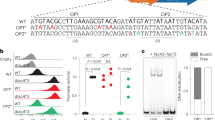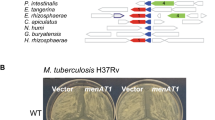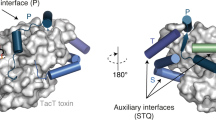Abstract
GCN5-related N-acetyl-transferase (GNAT)-like enzymes from toxin–antitoxin modules are strong inhibitors of protein synthesis. Here, we present the bases of the regulatory mechanisms of ataRT, a model GNAT-toxin–antitoxin module, from toxin synthesis to its action as a transcriptional de-repressor. We show the antitoxin (AtaR) traps the toxin (AtaT) in a pre-catalytic monomeric state and precludes the effective binding of ac-CoA and its target Met-transfer RNAfMet. In the repressor complex, AtaR intrinsically disordered region interacts with AtaT at two different sites, folding into different structures, that are involved in two separate functional roles, toxin neutralization and placing the DNA-binding domains of AtaR in a binding-compatible orientation. Our data suggests AtaR neutralizes AtaT as a monomer, right after its synthesis and only the toxin–antitoxin complex formed in this way is an active repressor. Once activated by dimerization, later neutralization of the toxin results in a toxin–antitoxin complex that is not able to repress transcription.
This is a preview of subscription content, access via your institution
Access options
Access Nature and 54 other Nature Portfolio journals
Get Nature+, our best-value online-access subscription
$29.99 / 30 days
cancel any time
Subscribe to this journal
Receive 12 print issues and online access
$259.00 per year
only $21.58 per issue
Buy this article
- Purchase on Springer Link
- Instant access to full article PDF
Prices may be subject to local taxes which are calculated during checkout






Similar content being viewed by others
Data availability
All the structures have been deposited in the PDB database with the following accession numbers: 6GTO, 6GTQ, 6GTP, 6GTR and 6GTS. All data needed to evaluate the conclusions in the paper are present in the paper and/or the Methods. Additional data related to this paper may be requested from the authors.
References
Dyda, F., Klein, D. C. & Hickman, A. B. GCN5-related N-acetyltransferases: a structural overview. Annu. Rev. Biophys. Biomol. Struct. 29, 81–103 (2000).
Jurėnas, D., Garcia-Pino, A. & Van Melderen, L. Novel toxins from type II toxin–antitoxin systems with acetyltransferase activity. Plasmid 93, 30–35 (2017).
Harms, A., Brodersen, D. E., Mitarai, N. & Gerdes, K. Toxins, targets, and triggers: an overview of toxin–antitoxin biology. Mol. Cell 70, 768–784 (2018).
Cheverton, A. M. et al. A Salmonella toxin promotes persister formation through acetylation of tRNA. Mol. Cell 63, 86–96 (2016).
Helaine, S. et al. Internalization of Salmonella by macrophages induces formation of nonreplicating persisters. Science 343, 204–208 (2014).
Goormaghtigh, F. et al. Reassessing the role of type II toxin–antitoxin systems in formation of Escherichia coli type II persister cells. mBio 9, e00640e-18 (2018).
Jurėnas, D. et al. AtaT blocks translation initiation by N-acetylation of the initiator tRNAfMet. Nat. Chem. Biol. 13, 640–646 (2017).
Rycroft, J. A. et al. Activity of acetyltransferase toxins involved in Salmonella persister formation during macrophage infection. Nat. Commun. 9, 1993 (2018).
Wilcox, B. et al. Escherichia coli ItaT is a type II toxin that inhibits translation by acetylating isoleucyl-tRNAIle. Nucleic Acids Res. 46, 7873–7885 (2018).
Jurėnas, D., Van Melderen, L. & Garcia-Pino, A. Crystallization and X-ray analysis of all of the players in the autoregulation of the ataRT toxin–antitoxin system. Acta Crystallogr. F Struct. Biol. Commun. 74, 391–401 (2018).
Loris, R. & Garcia-Pino, A. Disorder- and dynamics-based regulatory mechanisms in toxin–antitoxin modules. Chem. Rev. 114, 6933–6947 (2014).
Buts, L., Lah, J., Dao-Thi, M. H., Wyns, L. & Loris, R. Toxin–antitoxin modules as bacterial metabolic stress managers. Trends. Biochem. Sci. 30, 672–679 (2005).
Hayes, F. & Van Melderen, L. Toxins–antitoxins: diversity, evolution and function. Crit. Rev. Biochem. Mol. Biol. 46, 386–408 (2011).
Garcia-Pino, A. et al. An intrinsically disordered entropic switch determines allostery in Phd-Doc regulation. Nat. Chem. Biol. 12, 490–496 (2016).
Qian, H. et al. Identification and characterization of acetyltransferase-type toxin–antitoxin locus in Klebsiella pneumoniae. Mol. Microbiol. 108, 336–349 (2018).
Takamura, Y. & Nomura, G. Changes in the intracellular concentration of acetyl-CoA and malonyl-CoA in relation to the carbon and energy metabolism of Escherichia coli K12. J. Gen. Microbiol. 134, 2249–2253 (1988).
Vallari, D. S. & Jackowski, S. Biosynthesis and degradation both contribute to the regulation of coenzyme A content in. Escherichia coli. J. Bacteriol. 170, 3961–3966 (1988).
Kamada, K., Hanaoka, F. & Burley, S. K. Crystal structure of the MazE/MazF complex: molecular bases of antidote–toxin recognition. Mol. Cell 11, 875–884 (2003).
Kamada, K. & Hanaoka, F. Conformational change in the catalytic site of the ribonuclease YoeB toxin by YefM antitoxin. Mol. Cell 19, 497–509 (2005).
Hadži, S. et al. Ribosome-dependent Vibrio cholerae mRNAse HigB2 is regulated by a β-strand sliding mechanism. Nucleic Acids Res. 45, 4972–4983 (2017).
Garcia-Pino, A. et al. Doc of prophage P1 is inhibited by its antitoxin partner Phd through fold complementation. J. Biol. Chem. 283, 30821–30827 (2008).
Engel, P. et al. Adenylylation control by intra- or intermolecular active-site obstruction in Fic proteins. Nature 482, 107–110 (2012).
De Jonge, N. et al. Rejuvenation of CcdB-poisoned gyrase by an intrinsically disordered protein domain. Mol. Cell 35, 154–163 (2009).
Dao-Thi, M. H. et al. Intricate interactions within the ccd plasmid addiction system. J. Biol. Chem. 277, 3733–3742 (2002).
Madl, T. et al. Structural basis for nucleic acid and toxin recognition of the bacterial antitoxin CcdA. J. Mol. Biol. 364, 170–185 (2006).
Schreiter, E. R. & Drennan, C. L. Ribbon-helix-helix transcription factors: variations on a theme. Nat. Rev. Microbiol. 5, 710–720 (2007).
Ball, L. J., Kühne, R., Schneider-Mergener, J. & Oschkinat, H. Recognition of proline-rich motifs by protein-protein-interaction domains. Angew. Chem. Int. Edn Engl. 44, 2852–2869 (2005).
Ceregido, M. A. et al. Multimeric and differential binding of CIN85/CD2AP with two atypical proline-rich sequences from CD2 and Cbl-b*. FEBS. J. 280, 3399–3415 (2013).
Page, R. & Peti, W. Toxin–antitoxin systems in bacterial growth arrest and persistence. Nat. Chem. Biol. 12, 208–214 (2016).
Garcia-Pino, A. et al. Allostery and intrinsic disorder mediate transcription regulation by conditional cooperativity. Cell 142, 101–111 (2010).
Raumann, B. E., Rould, M. A., Pabo, C. O. & Sauer, R. T. DNA recognition by β-sheets in the Arc repressor-operator crystal structure. Nature 367, 754–757 (1994).
Schneidman-Duhovny, D., Hammel, M., Tainer, J. A. & Sali, A. FoXS, FoXSDock and MultiFoXS: single-state and multi-state structural modeling of proteins and their complexes based on SAXS profiles. Nucleic Acids Res. 44, W424–W429 (2016).
Andersen, J. B. et al. New unstable variants of green fluorescent protein for studies of transient gene expression in bacteria. Appl. Environ. Microbiol. 64, 2240–2246 (1998).
Chatterjee, A. N. & Park, J. T. Biosynthesis of cell wall mucopeptide by a particulate fraction from Staphylococcus aureus. Proc. Natl Acad. Sci. USA 51, 9–16 (1964).
Petit, J. F., Strominger, J. L. & Söll, D. Biosynthesis of the peptidoglycan of bacterial cell walls. VII. Incorporation of serine and glycine into interpeptide bridges in Staphylococcus epidermidis. J. Biol. Chem. 243, 757–767 (1968).
Hebecker, S. et al. Structures of two bacterial resistance factors mediating tRNA-dependent aminoacylation of phosphatidylglycerol with lysine or alanine. Proc. Natl Acad. Sci. USA 112, 10691–10696 (2015)
Tasaki, T., Sriram, S. M., Park, K. S. & Kwon, Y. T. The N-end rule pathway. Annu. Rev. Biochem. 81, 261–289 (2012).
Castro-Roa, D. et al. The Fic protein Doc uses an inverted substrate to phosphorylate and inactivate EF-Tu. Nat. Chem. Biol. 9, 811–817 (2013).
Garcia-Pino, A., Zenkin, N. & Loris, R. The many faces of Fic: structural and functional aspects of Fic enzymes. Trends. Biochem. Sci. 39, 121–129 (2014).
Marimon, O. et al. An oxygen-sensitive toxin–antitoxin system. Nat. Commun. 7, 13634 (2016).
Goeders, N. & Van Melderen, L. Toxin–antitoxin systems as multilevel interaction systems. Toxins 6, 304–324 (2014).
Bendtsen, K. L. et al. Toxin inhibition in C. crescentus VapBC1 is mediated by a flexible pseudo-palindromic protein motif and modulated by DNA binding. Nucleic Acids Res. 45, 2875–2886 (2017).
Kabsch, W. Xds. Acta Crystallogr. D. Biol. Crystallogr. 66, 125–132 (2010).
Evans, P. Scaling and assessment of data quality. Acta Crystallogr. D. Biol. Crystallogr. 62, 72–82 (2006).
Afonine, P. V. et al. Towards automated crystallographic structure refinement with phenix.refine. Acta Crystallogr. D. Biol. Crystallogr. 68, 352–367 (2012).
Sheldrick, G. M. Experimental phasing with SHELXC/D/E: combining chain tracing with density modification. Acta Crystallogr. D. Biol. Crystallogr. 66, 479–485 (2010).
Garcia-Pino, A., Buts, L., Wyns, L. & Loris, R. Interplay between metal binding and cis/trans isomerization in legume lectins: structural and thermodynamic study of P. angolensis lectin. J. Mol. Biol. 361, 153–167 (2006).
Acknowledgements
We acknowledge the use of the synchrotron-radiation facility at the Soleil synchrotron Gif-sur-Yvette, France, under proposals 20150717, 20160750 and 20170756; Diamond Light Source, Didcot, UK, under proposal MX9426; and access support from the European Community’s Seventh Framework Program (FP7/2007–2013) under BioStruct-X (projects 1673 and 6131). We also thank the staff from Swing, PROXIMA-1 and PROXIMA-2A beamlines at Soleil for assistance with data collection. F. Goormaghtigh and A. Talavera are thanked for technical assistance with the Flow Cytometry and SEC-multiangle light scattering measurements. This work was supported by grants from the Fonds National de Recherche Scientifique nos. FNRS-MIS F.4505.16, FNRS-EQP U.N043.17F, FRFS-WELBIO CR-2017S-03 and FNRS-PDR T.0066.18 to A.G.-P. and FNRS-PDR T.0147.15F and FNRS-CDR J.0061.16F to L.V.M.; the Program ‘Actions de Recherche Concertée’ 2016–2021 from the ULB, the Fonds d’Encouragement à la Recherche (FER) ULB to A.G.-P.; and the Fonds Jean Brachet and the Fondation Van Buuren to A.G.-P. and L.V.M. D.J. was supported by a PhD grant from the Fonds National de Recherche Scientifique FNRS-ASPIRANT.
Author information
Authors and Affiliations
Contributions
D.J., L.V.M. and A.G.-P. designed research. D.J. performed the research. D.J. and A.G.-P. analyzed the data. D.J., L.V.M. and A.G.-P. wrote the paper.
Corresponding author
Ethics declarations
Competing interests
The authors declare no competing interests.
Additional information
Publisher’s note: Springer Nature remains neutral with regard to jurisdictional claims in published maps and institutional affiliations.
Supplementary information
Supplementary Text and Figures
Supplementary Tables 1–5, Supplementary Figures 1–9
Rights and permissions
About this article
Cite this article
Jurėnas, D., Van Melderen, L. & Garcia-Pino, A. Mechanism of regulation and neutralization of the AtaR–AtaT toxin–antitoxin system. Nat Chem Biol 15, 285–294 (2019). https://doi.org/10.1038/s41589-018-0216-z
Received:
Accepted:
Published:
Issue Date:
DOI: https://doi.org/10.1038/s41589-018-0216-z
This article is cited by
-
Molecular stripping underpins derepression of a toxin–antitoxin system
Nature Structural & Molecular Biology (2024)
-
Identification and Characterization of HEPN-MNT Type II TA System from Methanothermobacter thermautotrophicus ΔH
Journal of Microbiology (2023)
-
Substrate recognition and cryo-EM structure of the ribosome-bound TAC toxin of Mycobacterium tuberculosis
Nature Communications (2022)
-
Structural and mutational analysis of MazE6-operator DNA complex provide insights into autoregulation of toxin-antitoxin systems
Communications Biology (2022)
-
A toxin-deformation dependent inhibition mechanism in the T7SS toxin-antitoxin system of Gram-positive bacteria
Nature Communications (2022)



